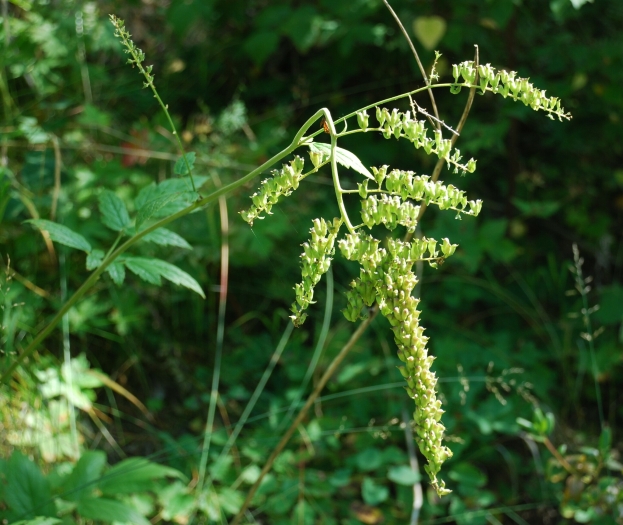Black Cohosh
(Actaea cimicifuga)
Black Cohosh (Actaea cimicifuga)
/
/

Татьяна Максимова
CC BY 4.0
Image By:
Татьяна Максимова
Recorded By:
Copyright:
CC BY 4.0
Copyright Notice:
Photo by: Татьяна Максимова | License Type: CC BY 4.0 | License URL: http://creativecommons.org/licenses/by/4.0/ | Rights Holder: Татьяна Максимова | Publisher: iNaturalist | Date Created: 2013-08-25T09:07:33-07:00 |

























Estimated Native Range
Summary
Actaea cimicifuga, commonly known as black cohosh, is a perennial herb native to Siberia to Korea. It can reach up to 2 meters in height and produces tall, wand-like racemes of small, creamy white flowers that bloom from June to September. The flowers are mildly fragrant and attract a variety of pollinators. Black cohosh has compound leaves that are deeply divided and toothed, contributing to its lush, fern-like appearance. The plant is particularly noted for its striking vertical form and the contrast its dark, bottlebrush flower spikes provide against the green foliage.
Black cohosh is appreciated in cultivation for its dramatic flower spikes and its ability to thrive in shady conditions, making it a popular choice for woodland gardens, shade gardens, and naturalized areas. It is also used in borders for vertical interest. This plant prefers consistently moist, rich soils with good drainage and can tolerate full to partial shade. While it is generally low maintenance, it can be susceptible to leaf spot and snail or slug damage. Black cohosh has a history of medicinal use by Native Americans and is currently used in alternative medicine, particularly for treating menopausal symptoms. However, gardeners should exercise caution as all parts of the plant are toxic if ingested.CC BY-SA 4.0
Black cohosh is appreciated in cultivation for its dramatic flower spikes and its ability to thrive in shady conditions, making it a popular choice for woodland gardens, shade gardens, and naturalized areas. It is also used in borders for vertical interest. This plant prefers consistently moist, rich soils with good drainage and can tolerate full to partial shade. While it is generally low maintenance, it can be susceptible to leaf spot and snail or slug damage. Black cohosh has a history of medicinal use by Native Americans and is currently used in alternative medicine, particularly for treating menopausal symptoms. However, gardeners should exercise caution as all parts of the plant are toxic if ingested.CC BY-SA 4.0
Plant Description
- Plant Type: Herb
- Height: 3-6 feet
- Width: 2-4 feet
- Growth Rate: Slow
- Flower Color: White
- Flowering Season: Summer, Fall
- Leaf Retention: Deciduous
Growth Requirements
- Sun: Full Shade
- Water: Medium
- Drainage: Medium
Common Uses
Border Plant, Butterfly Garden, Deer Resistant, Low Maintenance, Potted Plant, Street Planting
Other Names
Common Names: Black Cohosh, Fairy Candle, Bugbane, Foetid Bugbane, Sheng Ma, Black Snakeroot
Scientific Names: , Actaea cimicifuga, Actaea cimicifuga var. racemosa, Actaea dahurica, Actaea dahurica, Actaea frigida, Actaea frigida, Actaea macropoda, Actaea macropoda, Actaea mairei
GBIF Accepted Name: